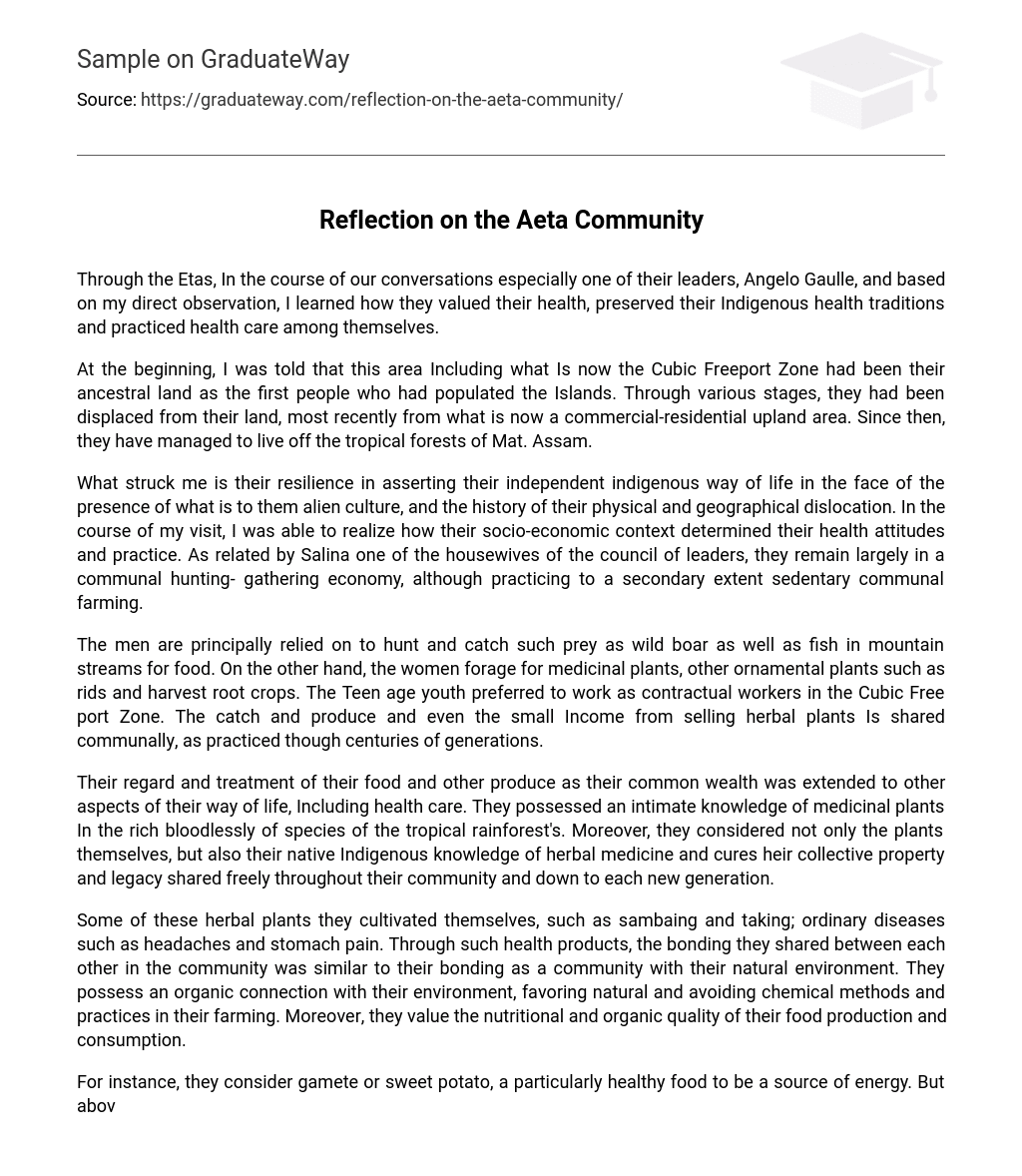Through the Etas, In the course of our conversations especially one of their leaders, Angelo Gaulle, and based on my direct observation, I learned how they valued their health, preserved their Indigenous health traditions and practiced health care among themselves.
At the beginning, I was told that this area Including what Is now the Cubic Freeport Zone had been their ancestral land as the first people who had populated the Islands. Through various stages, they had been displaced from their land, most recently from what is now a commercial-residential upland area. Since then, they have managed to live off the tropical forests of Mat. Assam.
What struck me is their resilience in asserting their independent indigenous way of life in the face of the presence of what is to them alien culture, and the history of their physical and geographical dislocation. In the course of my visit, I was able to realize how their socio-economic context determined their health attitudes and practice. As related by Salina one of the housewives of the council of leaders, they remain largely in a communal hunting- gathering economy, although practicing to a secondary extent sedentary communal farming.
The men are principally relied on to hunt and catch such prey as wild boar as well as fish in mountain streams for food. On the other hand, the women forage for medicinal plants, other ornamental plants such as rids and harvest root crops. The Teen age youth preferred to work as contractual workers in the Cubic Free port Zone. The catch and produce and even the small Income from selling herbal plants Is shared communally, as practiced though centuries of generations.
Their regard and treatment of their food and other produce as their common wealth was extended to other aspects of their way of life, Including health care. They possessed an intimate knowledge of medicinal plants In the rich bloodlessly of species of the tropical rainforest’s. Moreover, they considered not only the plants themselves, but also their native Indigenous knowledge of herbal medicine and cures heir collective property and legacy shared freely throughout their community and down to each new generation.
Some of these herbal plants they cultivated themselves, such as sambaing and taking; ordinary diseases such as headaches and stomach pain. Through such health products, the bonding they shared between each other in the community was similar to their bonding as a community with their natural environment. They possess an organic connection with their environment, favoring natural and avoiding chemical methods and practices in their farming. Moreover, they value the nutritional and organic quality of their food production and consumption.
For instance, they consider gamete or sweet potato, a particularly healthy food to be a source of energy. But above all, they regarded their particular variety of upland rice cooked and eaten whole-grain and unwilled as essential and the most important to their health. They also roast and grind this upland rice to make rice coffee, a beverage they greatly value for its health-giving properties. This kind of thinking can be said already, that they truly reflect an appreciation for food s a preventive medicine.
Since they regard their upland rice as their major source of nutrition, capable of serving as the only food in a meal, they do not sell their upland rice, whereas they sell what they consider to be less essential, such as their gamete and pub produce to outsiders. In this sense, it can be said that the Eat community values their health above considerations of income. Aside from their organic and ecological perspective, I found impressive the way members of their community all had free access to these health resources in the form of health food and herbal products and services.
Just as these goods and services were distributed in a communal way, so in the communal manner was governance practiced in the community, with the council of all tribal elders exercising decision-making powers for the community on health matters. For instance, the tribal council of elders decide collectively to send the sick to the hospital, when they already consider it necessary. This altruistic spirit and camaraderie contrasts highly with the egoistic culture fostered in modern or mainstream societies such as those dominant in the Philippines today.
Also impressive to me is their remarkable self-reliance as a community, their use of local resources near to them, the high collective respect for their own indigenous culture, and the great sense of dignity they possess based on a long cultural heritage. All this gives them a high level of well-being not enjoyed by the mainstream of Philippine society, which is by and large subject to various forms of cultural alienation. Finally, I realized that the mainstream of Filipino society can learn much from the health attitudes and practices of Eat communities in their organic.





